Addressing Noise and Skewness in Interpretable Health-Condition Assessment by Learning Model Confidence †
Abstract
1. Introduction
- Class skewness: As unhealthy conditions (e.g., diseases) occur rarely, the existence of class imbalance in health-condition monitoring records is inevitable. Classifying imbalanced data is a challenging problem [32]. Directly applying a machine learning algorithm may result in poor performance on the minority classes, as they are prone to ignore the subtle influence on the accuracy of an algorithm [33].
- Noisy segments: Most methods employ noise elimination approaches (e.g., grey spectral noise estimation [34], Dense Neural Network + spectrum-based noise elimination [35], CNN + Kalman filter [27], Encoder–Decoder [36], etc.) to denoise health-condition monitoring data, but they cannot deal with all of the noisy segments effectively, as the noisy segments refer to not only signal noise, but also the segments containing noisy labels. Taking a real-world electrocardiograph (ECG) record which is shown in Figure 1 as an example, its reference health-condition label given by cardiologists is ‘Atrial Fibrillation’. However, it may still contain some other types of segments (e.g., Normal sinus rhythm, etc.). Different from the irregular changes of the amplitude of segments with signal noises in the frequency domain or non-periodic variation in the time domain, only very subtle key differences in the segments that contain noisy labels can be found. For example, as shown in Figure 1, the morphological features of segments containing the noisy label of ‘Normal sinus rhythm’ are very similar to that containing only the ground-truth label of ‘Atrial fibrillation’, except that a ‘P wave’ only appears in the waveform of segments that contain the noisy label of ‘Normal sinus rhythm’. However, the traditional noise elimination methods cannot effectively deal with these segments with noisy labels which are very similar to that containing only reference labels in morphological features. Furthermore, in the field of health-condition assessment, the accuracy of the model may be greatly reduced when a monitoring record contains too many noises, and thus it may lead to sudden death, air crash, and other tragic events due to the misdiagnosis. Therefore, in addition to accurate health-condition detection from the good-quality monitoring data, automatic recognition of low-quality noisy signals is required as well to remind domain experts to intervene in time. Nevertheless, the use of noise elimination methods may affect the accuracy of the detection of low-quality noisy signals, as it may cause changes or losses of features representing the quality of the monitoring signal itself.
- Interpretability of prediction results: Most existing deep-learning-based methods are often regarded as black-box models, as they can only output a specific diagnosis result without necessary interpretability. Nevertheless, in the real-life scenario of health-condition assessment, to realize “why” is, for the most part, more important. To explain the results of Deep Neural Network (DNN) models, most methods use the attention mechanism to highlight segments of an input record which are strongly associated with the model prediction and consider them as an explanation of prediction results [37,38], while others measure the role of each feature in the prediction process [39,40]. However, these kinds of highlighted segments and exploration of feature effects can only provide auxiliary information, which cannot be a decision-making basis actually, as they cannot provide domain technological proofs. For instance, to achieve a sound balance between the best commercial and safety decision-making carefully, airlines may require detailed technological information on why the flight plan of an aircraft has to be suspended immediately. Thus, interpretable explanations of the model must be technological proofs with admissive knowledge which can be widely accepted by domain experts.
- We first employ a skewness-aware RCR-Net model to establish a general deep learning model, which can automatically obtain the features and handle problems of class skewness in a wide range of health-condition monitoring data.
- A diagnosis model based on K-margin is presented to automatically focus on the most essential segments associated with a monitoring record, and tackle noisy segments by using the expected consistency among the segments which are related to the same record. The classification of each monitoring record can be identified by selecting the most likely label of the relevant top-K augmented segments.
- A knowledge-directed interpretation method is proposed to learn how to extract features that can be regarded as important domain knowledge without the help of human experts from the time-series data automatically. As a result, one can use these domain knowledge-level features as an interpretable decision-making basis.
- Thorough experiments are carried out on Atrial Fibrillation Monitoring dataset [41] and Structural Damage Monitoring Dataset [42]. The experimental results demonstrate that the proposed method with 0.7974 and 0.8005 scores, respectively, which outperform all state-of-the-art deep learning methods for health-condition assessment tasks by and .
2. Methods
2.1. Problem Definition and General Framework
2.2. Skewness-Aware RCR-Net
2.3. Diagnosis Model Based on K-Margin
2.3.1. K-Margin-Based Noise Filtering
| Algorithm 1 K-margin() |
|
2.3.2. K-Margin-Based Health-Condition Detector
2.4. Knowledge-Directed Interpretation
3. Experiments
3.1. Dataset
- Atrial Fibrillation Monitoring Dataset [41]: 8528 ECG monitoring records, which last from 9 s to slightly more than 60 s, is contained. All ECG records were sampled as 300 Hz and they have been band pass filtered by the AliveCor device. However, there are still many signal noises contained in this dataset. To filter the low-quality monitoring signals, all monitoring records which contain too many signal noises would be classified into a category called “Too noisy to classify”. Moreover, all health conditions that are abnormal but not an atrial fibrillation (e.g., junctional arrhythmia, ventricular arrhythmia, etc.) are considered as a single category, that is, other rhythms. As a result, these records are divided into four categories of health conditions: (1) Normal sinus rhythm N (contains 5050 records, accounting for about ), (2) Atrial Fibrillation A (contains 738 records, accounting for about ), (3) Other rhythm O (contains 2456 records, accounting for about ), and (4) Too noisy to classify P (contains 284 records, accounting for about ).
- Aircraft Monitoring Dataset [42]: The aircraft structural damage monitoring dataset contains 808 labeled structural damage testing records lasting about 1 s sampling with 10 MHz. Each record has two channels—the baseline channel and monitoring channel. The data of the baseline channel were collected before the four-point bending test for composite laminates and impact test for stiffened plate were carried out. In addition, the data of the monitoring channel were collected during the four-point bending test and impact test. These records are classified as 2 health-condition class: (1) Normal N (contains 538 records, accounting for about ), (2) Structural damage D (contains 270 records, accounting for about ).
3.2. Performance Measurements
- .
- .
- scores of each class: Denoted as for normal sinus rhythm, for AF, for other rhythm, for noise. Detailed definitions can be found in [41].
- Averages of scores: .
- scores of Normal class:
- scores of Structural Damage class:
- Averages of scores:
3.3. Implementation Details
3.4. Comparing with Other Methods
- CNN uses a variation of multilayer perceptrons to automatically extract features. Recently, Sodmann et al. [49] constructed CNN architecture for health-condition assessment without manually extracted features.
- RNN can automatically extract the time-domain trend features by allowing it to exhibit temporal dynamic behavior. It is used as the major classifier for health-condition assessment in Faust et al. [20].
- CRNN takes advantage of convolutional neural networks (CNNs) for local feature extraction and recurrent neural networks (RNNs) for temporal summarization of the extracted features. The CRNN model is employed in Liu et al. [22] for detecting the unhealthy condition of myocardial infarction (MI).
- ResNet can build very deep networks through modules called residual layers, which can avoid higher errors rate due to naively adding CNN layers [43]. In Hannun et al. [24], it is employed for cardiac health-condition assessment, and the accuracy is comparable to or higher than that of cardiologists.
4. Results Discussion
4.1. Effect of Application in the Field of Medical Health
4.1.1. Effectiveness of Atrial Fibrillation Diagnosis
4.1.2. Interpretation Results of Atrial Fibrillation Diagnosis
4.2. Effect of Application in the Field of Aircraft Structural Health
4.2.1. Effectiveness of Aircraft Structural Damage Detection
4.2.2. Interpretation Results of Aircraft Structural Damage Detection
4.3. Analysis of the Influence of Hyper-Parameters
4.4. Discussion
- It can automatically adapt to the dataset with class skewness (e.g., the Atrial Fibrillation Monitoring dataset) and improve the model performance on the dataset without class skewness as well by improving the inadequacy of well-labeled data (e.g., the Aircraft Monitoring Dataset) using the skewness-aware RCR-Net model.
- No extra process of signal noise elimination is needed to help the prediction of health conditions from monitoring data that contains noisy segments (both segments with too many signal noises and segments with noisy labels).
- Low-quality noisy records can be reliably detected, as our method would not cause the problem of changes or losses of features representing the quality of the monitoring signal itself.
- Important domain knowledge features can be extracted without the help of human experts from the time-series data automatically. As a result, KEEN+ can provide an interpretable decision-making basis or technological proof by using these domain knowledge-level features.
- It needs extra computation when filtering the noisy segments. Nevertheless, the computational cost, which is , is very low compared with the computational cost of DNN methods. For example, for the experimental settings mentioned in Section 3, the extra computational cost of each monitoring record is = 60.
- The model performance could be influenced by the inaccuracy of the knowledge-level characteristics extracted from the dataset with high noise contamination. Comparing with the similar scores of KENN and KEEN+ on the Aircraft Monitoring Dataset, the accuracy of the KEEN+ method is slightly lower than that of the KEEN method on the Atrial Fibrillation Monitoring Dataset. This may be mainly because the noise contamination of the Atrial Fibrillation Monitoring Dataset is much higher, and thus the accuracy of the extracted knowledge-level characteristics is lower. From a performance perspective, the knowledge-level interpretation method does lower the model performance to some extent on the dataset with high noise contamination, but, considering that it can make results more explicable, this performance degradation is acceptable.
5. Conclusions
- The proposed methods KEEN and KEEN+ with 0.8125 and 0.7974 scores, which outperform all state-of-the-art DNN methods for health-condition assessment tasks by and on the Atrial Fibrillation Monitoring dataset with class skewness and noisy segments, indicate that the proposed methods can automatically adapt to the dataset with class skewness and noisy segments.
- The KEEN (with 0.8012 scores) and KEEN+ (with 0.8005 scores) are able to perform better by improving the inadequacy of well-labeled data and filtering the noisy segments on the Aircraft Monitoring Dataset without class skewness.
- KEEN and KEEN+ show good performance with 0.7561 and 0.6995 scores for detecting the low-quality records (“Too Noisy To Classify”) which outperform other DNN methods by and on the Atrial Fibrillation Monitoring dataset.
- The model interpretation shows improvement in the results compared to other DNN methods, as KEEN+ can provide domain knowledge-level features as technological proofs for the results of health-condition assessment.
Author Contributions
Funding
Conflicts of Interest
Abbreviations
| DNN | Deep Neural Network |
| CNN | Convolutional Neural Network |
| RNN | Recurrent Neural Network |
| CRNN | Convolutional Recurrent Neural Network |
| ResNet | Residual Neural Networks |
| Bi-LSTM | Bi-Directional Long-Short Term Memory |
| RCR-Net | Residual-Convolution-Recurrent Neural Network |
| K-margin | K-Margin-Based Health-Condition Label Prediction Algorithm |
| KEEN | K-Margin-Based Interpretable Learning |
| MSE | Mean Square Error Loss |
| ECG | Electrocardiograph |
| AF | Atrial Fibrillation |
References
- Tateno, K.; Glass, L. Automatic detection of atrial fibrillation using the coefficient of variation and density histograms of RR and ΔRR intervals. Med. Biol. Eng. Comput. 2001, 39, 664–671. [Google Scholar] [CrossRef] [PubMed]
- Faust, O.; Acharya, U.R.; Min, L.C.; Sputh, B.H.C. Automatic identification of epileptic and background EEG signals using frequency domain parameters. Int. J. Neural Syst. 2010, 20, 159–176. [Google Scholar] [CrossRef] [PubMed]
- Faust, O.; Acharya, U.R.; Molinari, F.; Chattopadhyay, S.; Tamura, T. Linear and nonlinear analysis of cardiac health in diabetic subjects. Biomed. Signal Process. Control 2012, 7, 295–302. [Google Scholar] [CrossRef]
- Linker, D. Accurate, automated detection of atrial fibrillation in ambulatory recordings. Cardiovasc. Eng. Technol. 2016, 7, 182–189. [Google Scholar] [CrossRef]
- Hong, S.; Zhou1, Y.; Wu, M.; Shang, J.; Wang, Q.; Li1, H.; Xie, J. Combining deep neural networks and engineered features for cardiac arrhythmia detection from ECG recordings. Physiol. Meas. 2019, 40, 054009. [Google Scholar] [CrossRef]
- Ichikawa, K.; Tamano, H. Unsupervised Qualitative Scoring for Binary Item Features. Data Sci. Eng. 2020, 5, 317–330. [Google Scholar] [CrossRef]
- Kumar, R.; Bishnu, P.S. Identification of k-Most Promising Features to Set Blue Ocean Strategy in Decision Making. Data Sci. Eng. 2019, 4, 367–384. [Google Scholar] [CrossRef]
- Ieracitano, C.; Mammone, N.; Hussain, A.; Morabito, F.C. A Convolutional Neural Network based self-learning approach for classifying neurodegenerative states from EEG signals in dementia. In Proceedings of the IEEE International Joint Conference on Neural Networks (IJCNN)), Shenzheng, China, 18–22 July 2020; pp. 1–8. [Google Scholar]
- Bornn, L.; Farrar, C.R.; Park, G.; Farinholt, K. Structural health monitoring with autoregressive support vector machines. J. Vib. Acoust. 2009, 131, 021004. [Google Scholar] [CrossRef]
- Carrara, M.; Carozzi, L.; Moss, T.J.; de Pasquale, M.; Cerutti, S.; Ferrario, M.; Lake, D.E.; Moorman, J.R. Heart rate dynamics distinguish among atrial fibrillation, normal sinus rhythm and sinus rhythm with frequent ectopy. Physiol. Meas. 2015, 36, 1873. [Google Scholar] [CrossRef] [PubMed]
- Ni, Y.Q.; Wang, Y.W.; Zhang, C. A Bayesian approach for condition assessment and damage alarm of bridge expansion joints using long-term structural health monitoring data. Eng. Struct. 2020, 212, 110520. [Google Scholar] [CrossRef]
- Kiranyaz, S.; Ince, T.; Gabbouj, M. Real-time patient-specific ECG classification by 1D convolutional neural networks. IEEE Trans. Biomed. Eng. 2015, 63, 664–675. [Google Scholar] [CrossRef] [PubMed]
- Kamaleswaran, R.; Mahajan, R.; Akbilgic, O. A robust deep convolutional neural network for the classification of abnormal cardiac rhythm using single lead electrocardiograms of variable length. Physiol. Meas. 2018, 39, 035006. [Google Scholar] [CrossRef] [PubMed]
- Hu, B.; Hu, Z.; Ran, L.; Mawby, P.; Jia, C.; Ng, C.; McKeever, P. Deep Learning Neural Networks for Heat-Flux Health Condition Monitoring Method of Multi-Device Power Electronics System. In Proceedings of the IEEE Energy Conversion Congress and Exposition (ECCE), Baltimore, MD, USA, 29 September–3 October 2019; pp. 3769–3774. [Google Scholar]
- San, K.T.; Sohn, S.Y. Multitask learning for health condition identification and remaining useful life prediction: Deep convolutional neural network approach. J. Intell. Manuf. 2020, 1–11. [Google Scholar] [CrossRef]
- Hong, S.; Xu, Y.; Khare, A.; Priambada, S.; Maher, K.O.; Aljiffry, A.; Sun, J.; Tumanov, A. HOLMES: Health Online Model Ensemble Serving for Deep Learning Models in Intensive Care Units. In Proceedings of the 26th ACM SIGKDD International Conference on Knowledge Discovery & Data Mining, Virtual Event, Los Angeles, CA, USA, 23–27 August 2020; pp. 1614–1624. [Google Scholar]
- Schwab, P.; Scebba, G.C.; Zhang, J.; Delai, M.; Karlen, W. Beat by beat: Classifying cardiac arrhythmias with recurrent neural networks. In Proceedings of the IEEE Computing in Cardiology (CinC), Nice, France, 24–27 September 2017; pp. 1–4. [Google Scholar]
- Faust, O.; Shenfield, A.; Kareem, M.; San, T.R.; Fujita, H.; Acharya, U.R. Automated detection of atrial fibrillation using long short-term memory network with RR interval signals. Comput. Biol. Med. 2018, 102, 327–335. [Google Scholar] [CrossRef]
- Warrick, P.A.; Homsi, M.N. Ensembling convolutional and long short-term memory networks for electrocardiogram arrhythmia detection. Physiol. Meas. 2018, 39, 114002. [Google Scholar] [CrossRef]
- Faust, O.; Kareem, M.; Shenfield, A.; Ali, A.; Acharya, U.R. Validating the robustness of an internet of things based atrial fibrillation detection system. Pattern Recognit. Lett. 2020, 133, 55–61. [Google Scholar] [CrossRef]
- Liang, K.; Qin, N.; Huang, D.; Fu, Y. Convolutional recurrent neural network for fault diagnosis of high-speed train bogie. Complexity 2018, 2018, 4501952. [Google Scholar] [CrossRef]
- Liu, W.; Wang, F.; Huang, Q.; Chang, S.; Wang, H.; He, J. MFB-CBRNN: A hybrid network for MI detection using 12-lead ECGs. IEEE J. Biomed. Health Inform. 2020, 24, 503–514. [Google Scholar] [CrossRef]
- Hong, S.; Wang, C.; Fu, Z. Gated Temporal Convolutional Neural Network and Expert Features for Diagnosing and Explaining Physiological Time Series: A Case Study on Heart Rates. Comput. Methods Programs Biomed. 2020, 105847. [Google Scholar] [CrossRef]
- Hannun, A.Y.; Rajpurkar, P.; Haghpanahi, M.; Tison, G.H.; Bourn, C.; Turakhia, M.P.; Ng, A.Y. Cardiologist-level arrhythmia detection and classification in ambulatory electrocardiograms using a deep neural network. Nat. Med. 2019, 25, 65. [Google Scholar] [CrossRef]
- Shen, Y.; Voisin, M.; Aliamiri, A.; Avati, A.; Hannun, A.; Ng, A. Ambulatory atrial fibrillation monitoring using wearable photoplethysmography with deep learning. In Proceedings of the 25th ACM International Conference on Knowledge Discovery and Data Mining (SIGKDD), Anchorage, AK, USA, 4–8 August 2019; pp. 1909–1916. [Google Scholar]
- Ieracitano, C.; Mammone, N.; Hussain, A.; Morabito, F.C. A novel multi-modal machine learning based approach for automatic classification of EEG recordings in dementia. Neural Netw. 2020, 123, 176–190. [Google Scholar] [CrossRef] [PubMed]
- Oh, B.K.; Glisic, B.; Kim, Y.; Park, H.S. Convolutional neural network-based wind-induced response estimation model for tall buildings. Comput. Aided Civ. Infrastruct. Eng. 2019, 34, 843–858. [Google Scholar] [CrossRef]
- Lih, O.S.; Jahmunah, V.; San, T.R.; Ciaccio, E.J.; Yamakawa, T.; Tanabe, M.; Kobayashi, M.; Faust, O.; Acharya, U.R. Comprehensive electrocardiographic diagnosis based on deep learning. Artif. Intell. Med. 2020, 103, 101789. [Google Scholar] [CrossRef] [PubMed]
- Zhou, Y.; Hong, S.; Shang, J.; Wu, M.; Wang, Q.; Li, H.; Xie, J. K-margin-based residual-convolution-recurrent neural network for atrial fibrillation detection. In Proceedings of the 28th International Joint Conference on Artificial Intelligence (IJCAI), Macao, China, 10–16 August 2019; pp. 6057–6063. [Google Scholar]
- Sun, C.; Hong, S.; Song, M.; Li, H. A Review of Deep Learning Methods for Irregularly Sampled Medical Time Series Data. arXiv 2020, arXiv:2010.12493. [Google Scholar]
- Hong, S.; Zhou, Y.; Shang, J.; Xiao, C.; Sun, J. Opportunities and challenges of deep learning methods for electrocardiogram data: A systematic review. Comput. Biol. Med. 2020, 122, 103801. [Google Scholar] [CrossRef] [PubMed]
- Branco, P.; Torgo, L.; Ribeiro, R.P. A survey of predictive modeling on imbalanced domains. ACM Comput. Surv. (CSUR) 2016, 49, 1–50. [Google Scholar] [CrossRef]
- Lu, Y.; Cheung, Y.; Tang, Y.Y. Dynamic Weighted Majority for Incremental Learning of Imbalanced Data Streams with Concept Drift. In Proceedings of the 26th International Joint Conference on Artificial Intelligence (IJCAI), Melbourne, Australia, 19–25 August 2017; pp. 2393–2399. [Google Scholar]
- Liu, S.-H.; Hsieh, C.-H.; Chen, W.; Tan, T.-H. ECG noise cancellation based on grey spectral noise estimation. Sensors 2019, 19, 798. [Google Scholar] [CrossRef]
- Zhao, Z.; Särkkä, S.; Rad, A.B. Kalman-based Spectro-Temporal ECG Analysis using Deep Convolutional Networks for Atrial Fibrillation Detection. J. Signal Process. Syst. 2020, 92, 621–636. [Google Scholar] [CrossRef]
- Reljin, N.; Lazaro, J.; Hossain, M.B.; Noh, Y.S.; Cho, C.H.; Chon, K.H. Using the Redundant Convolutional Encoder-Decoder to Denoise QRS Complexes in ECG Signals Recorded with an Armband Wearable Device. Sensors 2020, 20, 4611. [Google Scholar] [CrossRef]
- Xu, Y.; Biswal, S.; Deshpande, S.R.; Maher, K.O.; Sun, J. Raim: Recurrent attentive and intensive model of multimodal patient monitoring data. In Proceedings of the 24th ACM International Conference on Knowledge Discovery & Data Mining (SIGKDD), London, UK, 19–23 August 2018; pp. 2565–2573. [Google Scholar]
- Hong, S.; Xiao, C.; Ma, T.; Li, H.; Sun, J. Mina: Multilevel knowledge-guided attention for modeling electrocardiography signals. In Proceedings of the 28th International Joint Conference on Artificial Intelligence (IJCAI), Macao, China, 10–16 August 2019; pp. 5888–5894. [Google Scholar]
- Ribeiro, M.T.; Singh, S.; Guestrin, C. “Why should i trust you?” Explaining the predictions of any classifier. In Proceedings of the 22nd ACM International Conference on Knowledge Discovery and Data Mining (SIGKDD), San Francisco, CA, USA, 13–17 August 2016; pp. 1135–1144. [Google Scholar]
- Lundberg, S.M.; Lee, S.I. A unified approach to interpreting model predictions. In Proceedings of the 31st International Conference on Neural Information Processing Systems (NIPS), Long Beach, CA, USA, 4–9 December 2017; pp. 4765–4774. [Google Scholar]
- Clifford, G.D.; Liu, C.; Moody, B.; Lehman, L.H.; Silva, I.; Li, Q.; Johnson, A.E.; Mark, R.G. AF Classification from a short single lead ECG recording: The PhysioNet/Computing in Cardiology Challenge 2017. In Proceedings of the IEEE Computing in Cardiology (CinC), Nice, France, 24–27 September 2017; pp. 1–4. [Google Scholar]
- Yang, Y.; Zhou, Y.; Wang, L. Integrated Method of Multiple Machine-Learning Models for Damage Recognition. J. Data Acquis. Process. 2020, 35, 278–287. [Google Scholar]
- He, K.; Zhang, X.; Ren, S.; Sun, J. Deep residual learning for image recognition. In Proceedings of the IEEE Conference on Computer Vision and Pattern Recognition (CVPR), Las Vegas, NV, USA, 26 June–1 July 2016; pp. 770–778. [Google Scholar]
- Saeedan, F.; Weber, N.; Goesele, M.; Roth, S. Detail-preserving pooling in deep networks. In Proceedings of the IEEE Conference on Computer Vision and Pattern Recognition (CVPR), Salt Lake City, UT, USA, 18–22 June 2018; pp. 9108–9116. [Google Scholar]
- Goldberger, A.L.; Amaral, L.A.N.; Glass, L.; Hausdorff, J.M.; Ivanov, P.C.; Mark, R.G.; Mietus, J.E.; Moody, G.B.; Peng, C.-K.; Stanley, H.E. PhysioBank, PhysioToolkit, and PhysioNet: Components of a new research resource for complex physiologic signals. Circulation 2000, 101, e215–e220. [Google Scholar] [CrossRef] [PubMed]
- Betz1, D.C.; Staszewski1, W.J.; Thursby, G.; Culshaw, B. Structural damage identification using multifunctional Bragg grating sensors: II. Damage detection results and analysis. Smart Mater. Struct. 2006, 15, 1313. [Google Scholar] [CrossRef]
- Michaels, J.E.; Michaels, T.E. An integrated strategy for detection and imaging of damage using a spatially distributed array of piezoelectric sensors. In Proceedings of the Health Monitoring of Structural and Biological Systems, San Diego, CA, USA, 18–22 March 2007. [Google Scholar]
- Gao, H.; Shi, Y.; Ros, J.L. Guided wave tomography on an aircraft wing with leave in place sensors. In Proceedings of the AIP Conference, Paris, France, 18–22 July 2005; Volume 760, pp. 1788–1794. [Google Scholar]
- Sodmann, P.; Vollmer, M.; Nath, N.; Kaderali, L. A convolutional neural network for ECG annotation as the basis for classification of cardiac rhythms. Physiol. Meas. 2018, 39, 104005. [Google Scholar] [CrossRef] [PubMed]

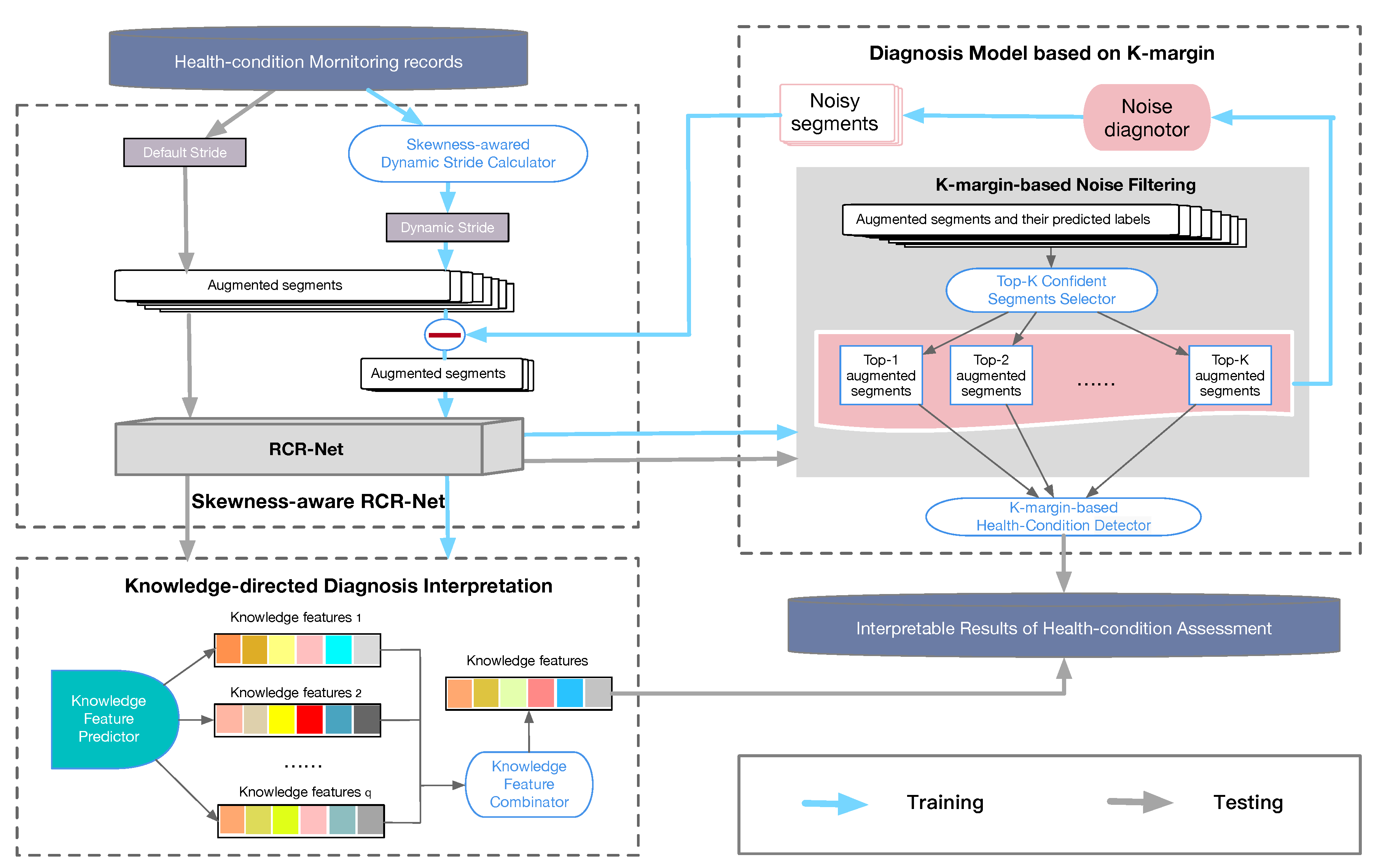
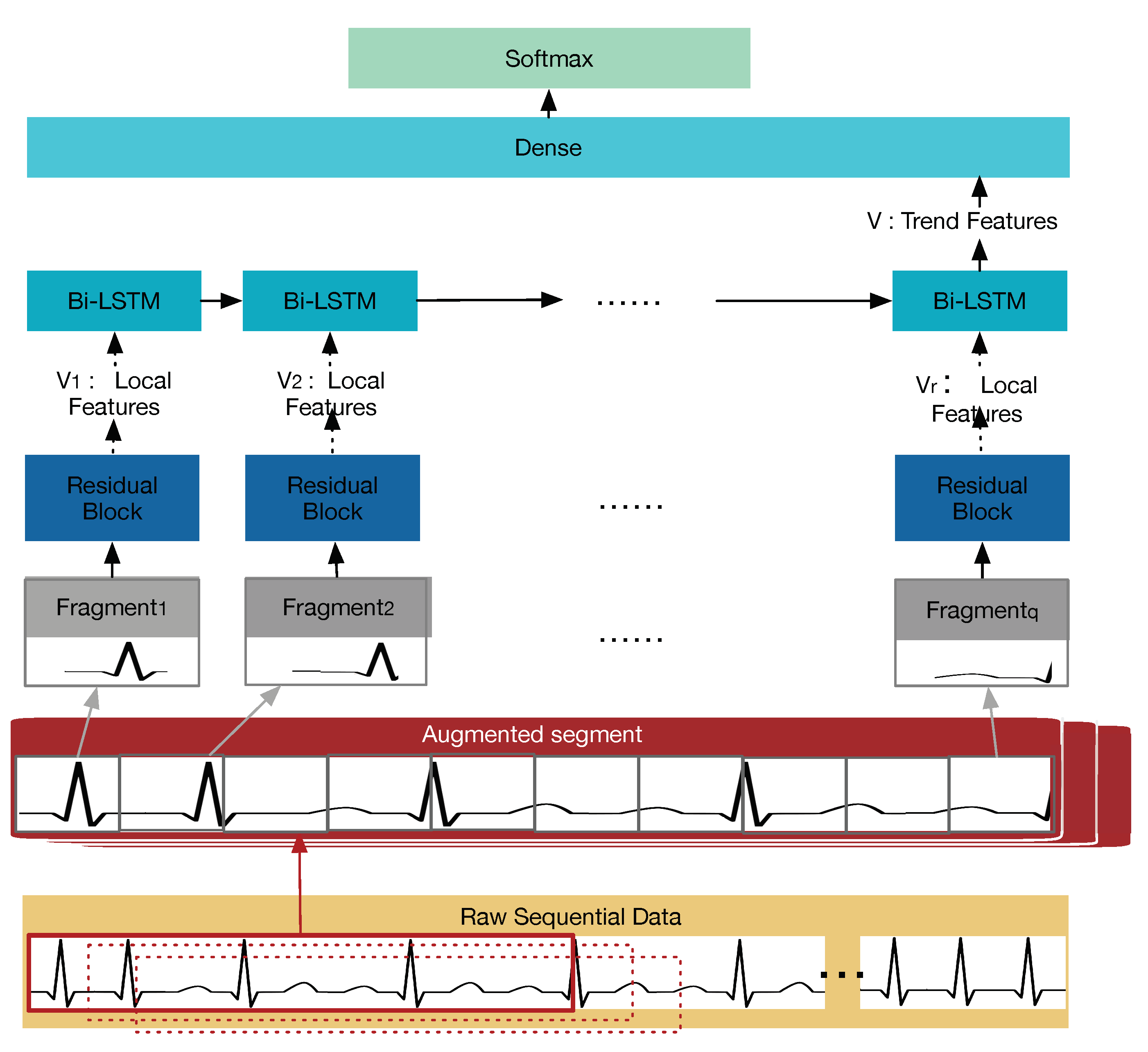
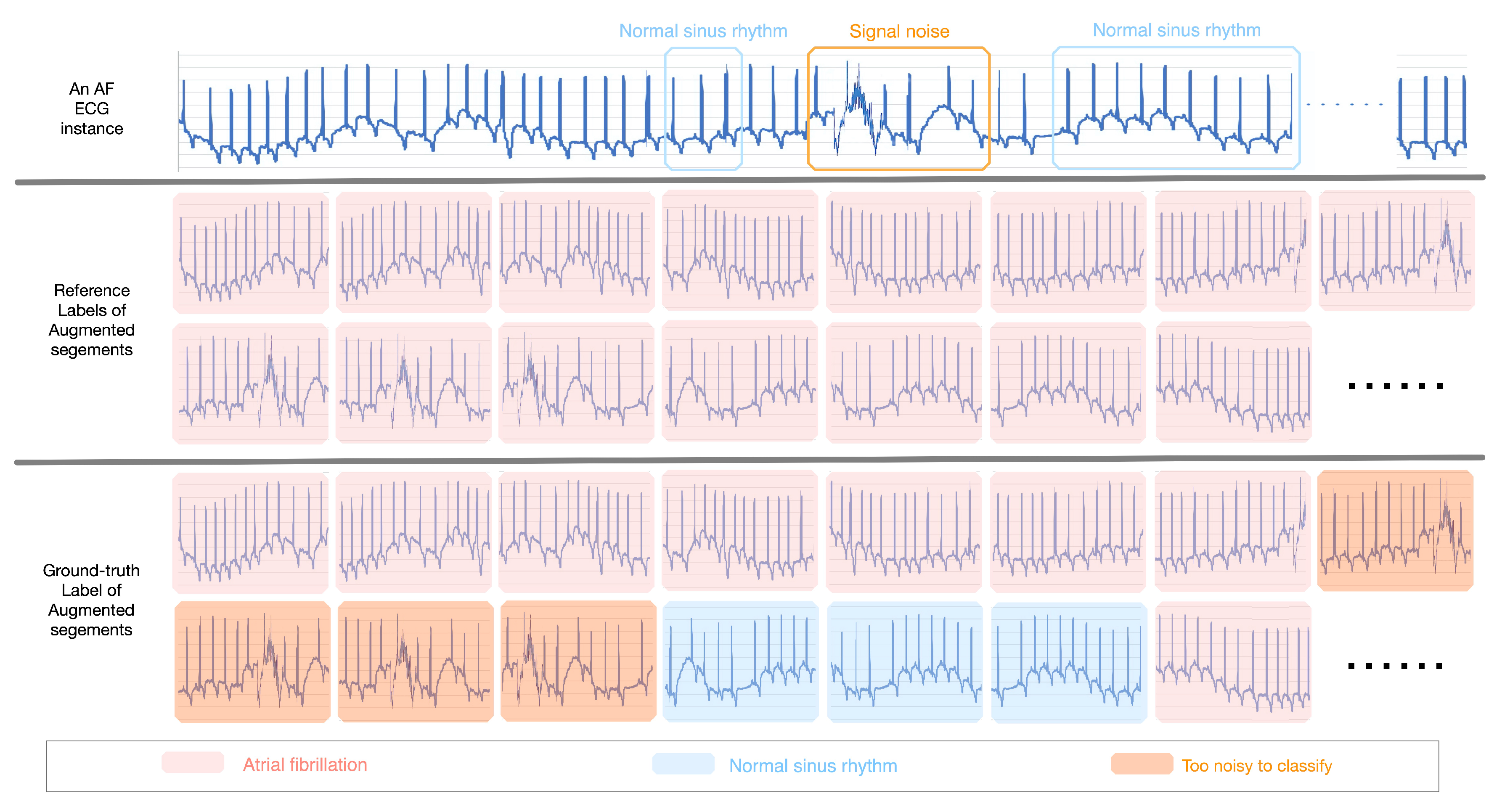
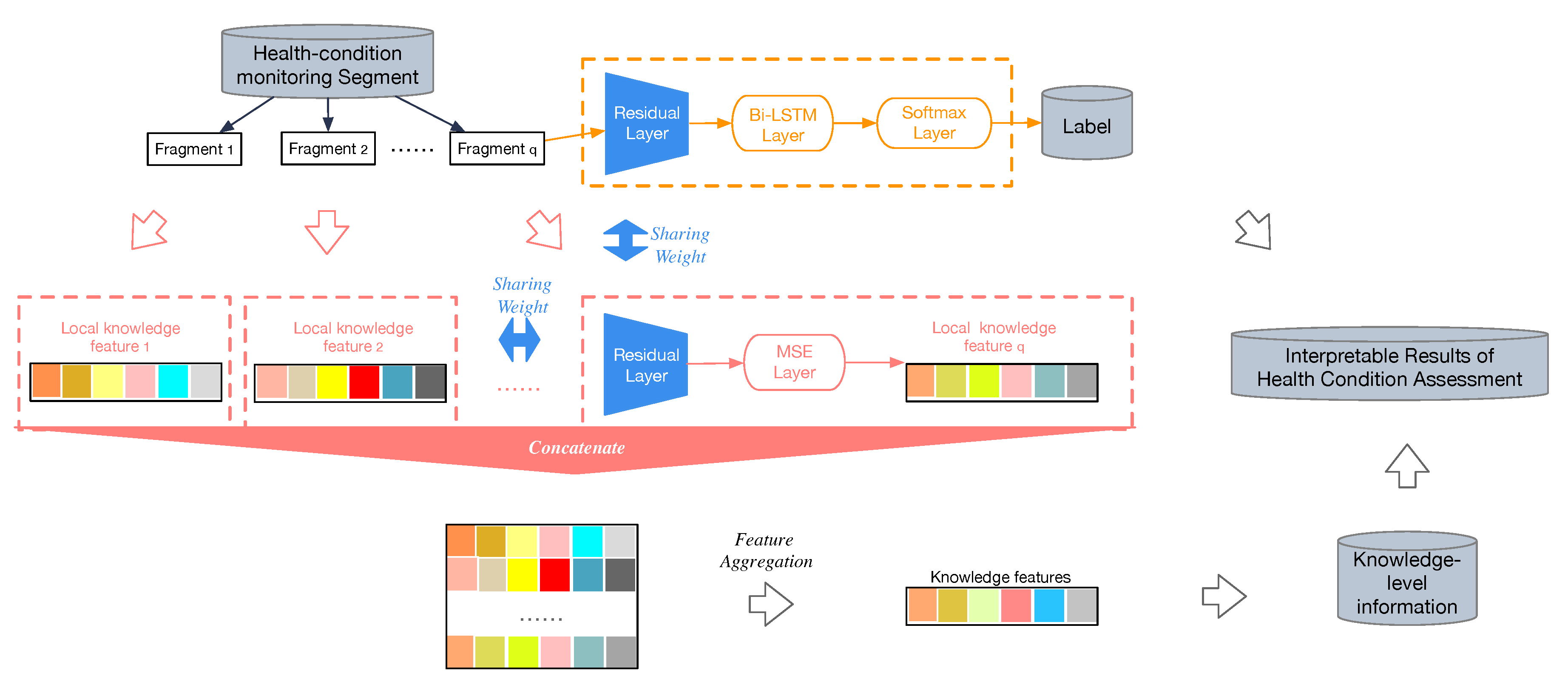
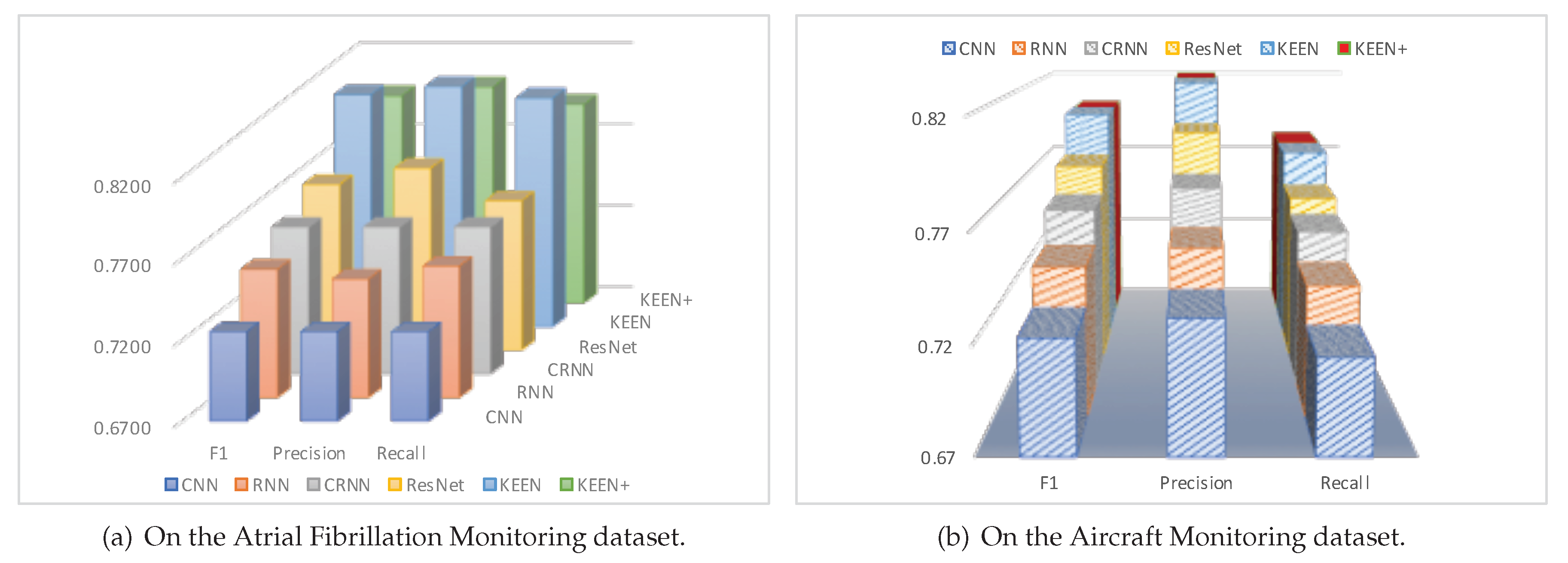
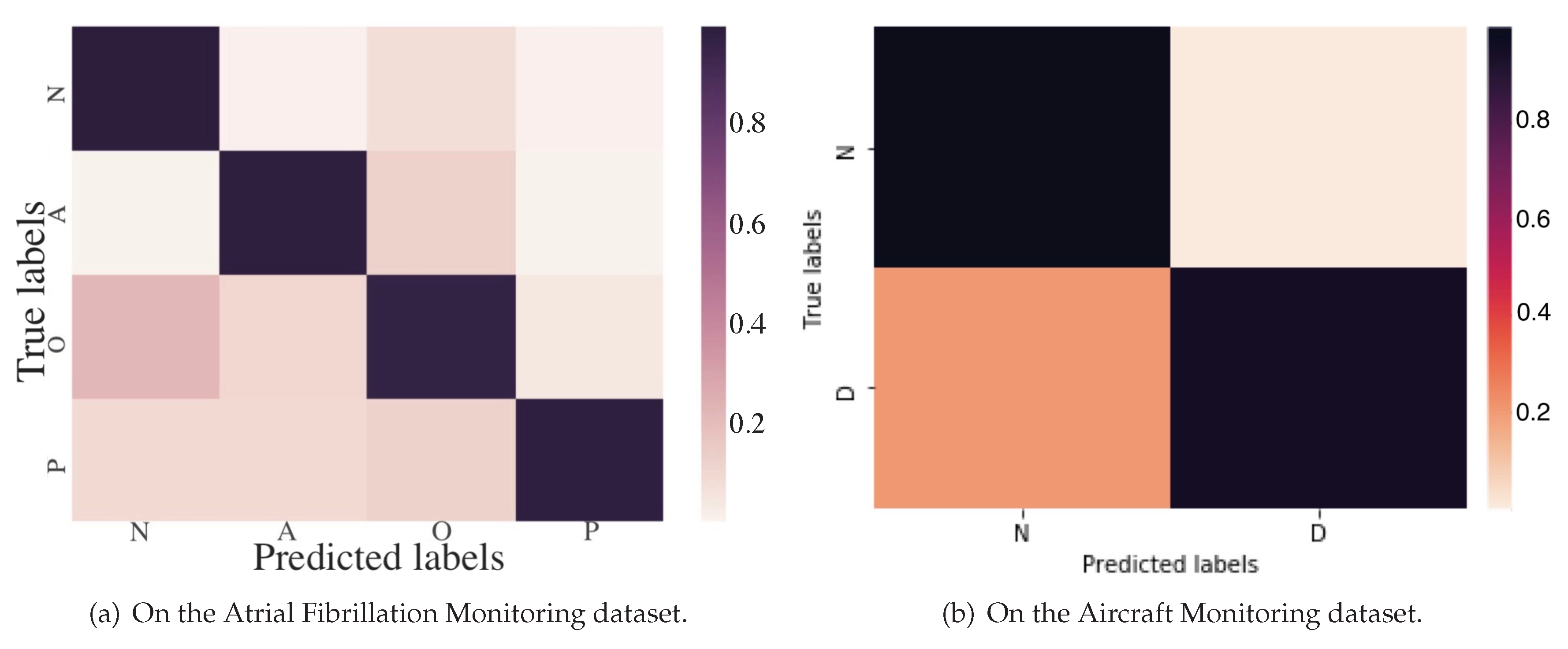
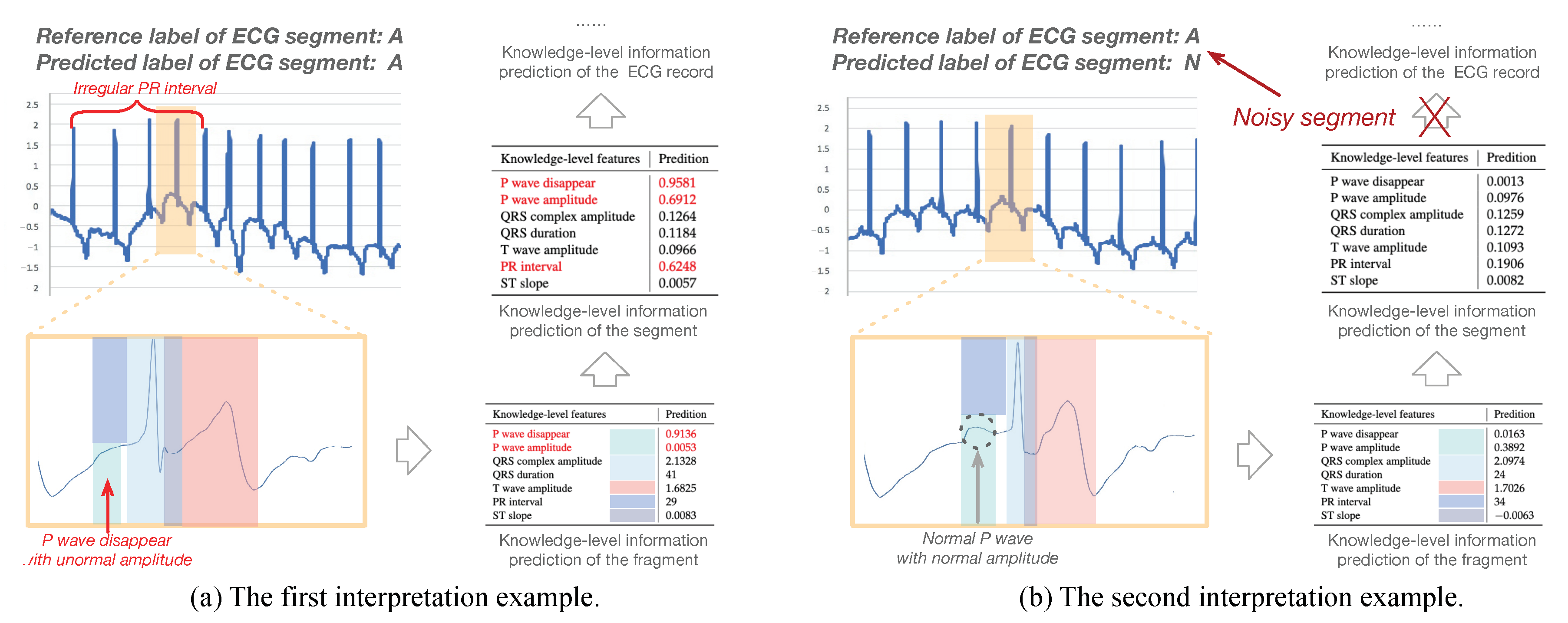
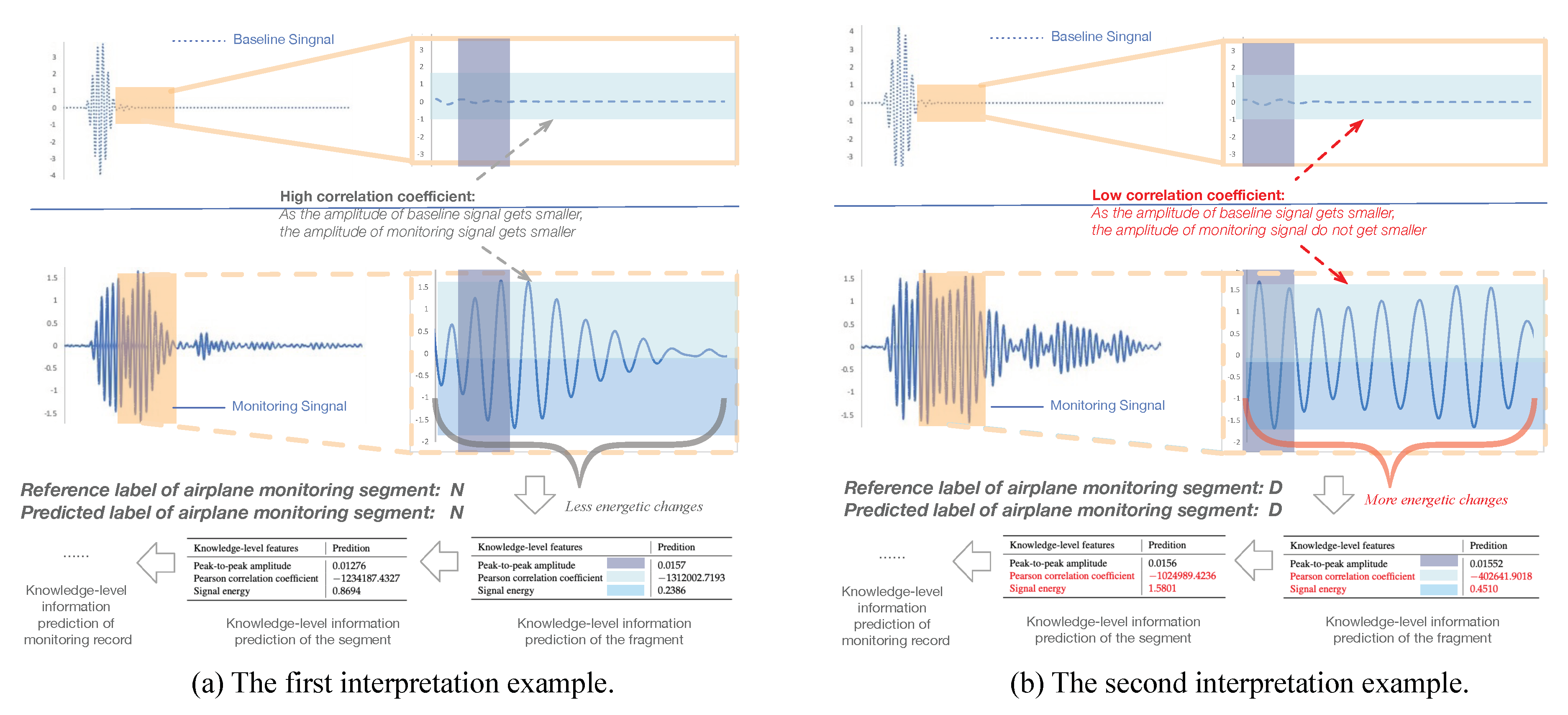

| Predicted Class | ||||
|---|---|---|---|---|
| Reference Class | Normal(N) | Structural Damage(D) | Total | |
| Normal(N) | ||||
| Structural Damage(D) | ||||
| Total | ||||
| Method | |||||
|---|---|---|---|---|---|
| CNN | 0.9123 | 0.8140 | 0.7097 | 0.4636 | 0.7249 |
| RNN | 0.9187 | 0.8100 | 0.7834 | 0.4829 | 0.7488 |
| RCNN | 0.9190 | 0.8221 | 0.7319 | 0.5676 | 0.7602 |
| ResNet | 0.9056 | 0.8431 | 0.7415 | 0.5873 | 0.7719 |
| KEEN | 0.9061 | 0.8712 | 0.7166 | 0.7561 | 0.8125 |
| KEEN+ | 0.9053 | 0.8704 | 0.7142 | 0.6995 | 0.7974 |
| Knowledge-Level Features | Average Error |
|---|---|
| P wave disappear | |
| P wave amplitude | |
| QRS complex amplitude | |
| QRS duration | |
| T wave amplitude | |
| PR interval | |
| ST slope |
| Knowledge-Level Features | Average Error |
|---|---|
| Peak-to-peak amplitude | |
| Pearson correlation coefficient | |
| Signal energy |
Publisher’s Note: MDPI stays neutral with regard to jurisdictional claims in published maps and institutional affiliations. |
© 2020 by the authors. Licensee MDPI, Basel, Switzerland. This article is an open access article distributed under the terms and conditions of the Creative Commons Attribution (CC BY) license (http://creativecommons.org/licenses/by/4.0/).
Share and Cite
Zhou, Y.; Hong, S.; Shang, J.; Wu, M.; Wang, Q.; Li, H.; Xie, J. Addressing Noise and Skewness in Interpretable Health-Condition Assessment by Learning Model Confidence. Sensors 2020, 20, 7307. https://doi.org/10.3390/s20247307
Zhou Y, Hong S, Shang J, Wu M, Wang Q, Li H, Xie J. Addressing Noise and Skewness in Interpretable Health-Condition Assessment by Learning Model Confidence. Sensors. 2020; 20(24):7307. https://doi.org/10.3390/s20247307
Chicago/Turabian StyleZhou, Yuxi, Shenda Hong, Junyuan Shang, Meng Wu, Qingyun Wang, Hongyan Li, and Junqing Xie. 2020. "Addressing Noise and Skewness in Interpretable Health-Condition Assessment by Learning Model Confidence" Sensors 20, no. 24: 7307. https://doi.org/10.3390/s20247307
APA StyleZhou, Y., Hong, S., Shang, J., Wu, M., Wang, Q., Li, H., & Xie, J. (2020). Addressing Noise and Skewness in Interpretable Health-Condition Assessment by Learning Model Confidence. Sensors, 20(24), 7307. https://doi.org/10.3390/s20247307





